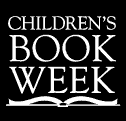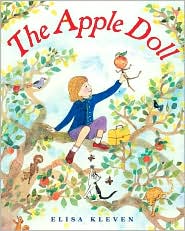Picture Book Round-Up: The Sidekick Edition, Part Two
 November 15th, 2007 by jules
November 15th, 2007 by jules
I’ve got sidekicks on the mind this week and started a short picture book round-up yesterday with Mighty Max and his sidekick, Power Pinky. Here are a couple more . . .

Written by Natasha Wing
Illustrated by Sylvie Kantorovitz
Harcourt
September 2007
Move over, Harold. Meet Lucy, who also has the power to create a world of her own by simply drawing it. This is one of the best picture books I’ve seen this year — not to mention the celebration-of-books that this title is makes it a perfect book to highlight during this, Children’s Book Week. What we have here is a young girl who simply can’t get to sleep: “She could not, would not, did not want to go to bed.” Deciding she wants to draw, she creates a monster with an oval body, square head, rectangle legs, circle eyes, and extra  added triangular spiky scales on his back. And power to Lucy: What does she immediately say to her new creation? “You don’t scare me . . . Let’s play!” So, the playing ensues: building castles, flying airplanes (which frightens our new monster a wee bit), marching in a parade, skipping, jumping, crawling, you-name-it — which all, of course, tires Lucy out. Turning the tables on the child/caregiver relationship and the usual bedtime struggles, Wing has Lucy try every tactic she can think of to get Monster to bed and to fulfill his needs: She draws him a bed, but he refuses to go to sleep; when he screams that he’s hungry, she draws him a mountain of meatballs; and when he yells “Potty,” she draws a bathroom.
added triangular spiky scales on his back. And power to Lucy: What does she immediately say to her new creation? “You don’t scare me . . . Let’s play!” So, the playing ensues: building castles, flying airplanes (which frightens our new monster a wee bit), marching in a parade, skipping, jumping, crawling, you-name-it — which all, of course, tires Lucy out. Turning the tables on the child/caregiver relationship and the usual bedtime struggles, Wing has Lucy try every tactic she can think of to get Monster to bed and to fulfill his needs: She draws him a bed, but he refuses to go to sleep; when he screams that he’s hungry, she draws him a mountain of meatballs; and when he yells “Potty,” she draws a bathroom.  He’s cold, he’s scared, he wants to play more, he’s simply not sleepy — nothing will get him to bed. Not until Lucy grabs a book. “‘Book!’ cheered Monster. ‘Only if you get into bed,’ said Lucy.” And this is the one successful tactic that sends her Monster off to slumber-land. Kantorovitz’s pastel-colored oil paint/pastel illustrations are wonderfully deceiving, intentionally made to look like, it seems, crayon drawings, particularly since our fearless protagonist usually has crayon in hand, ready to accommodate the sidekick-from-her-mind, brought to her by her late-night artistic muse. Children will delight in and relate to the angular monster — who manages to have a dizzying array of facial expressions and moods, thanks to Kantorovitz and even though he has just circles for eyes and a couple lines for a mouth — and his bed-delaying tactics. They will also cheer Lucy’s bravado and finesse in dealing with the stubborn, child-like monster. Great fun. Don’t miss it.
He’s cold, he’s scared, he wants to play more, he’s simply not sleepy — nothing will get him to bed. Not until Lucy grabs a book. “‘Book!’ cheered Monster. ‘Only if you get into bed,’ said Lucy.” And this is the one successful tactic that sends her Monster off to slumber-land. Kantorovitz’s pastel-colored oil paint/pastel illustrations are wonderfully deceiving, intentionally made to look like, it seems, crayon drawings, particularly since our fearless protagonist usually has crayon in hand, ready to accommodate the sidekick-from-her-mind, brought to her by her late-night artistic muse. Children will delight in and relate to the angular monster — who manages to have a dizzying array of facial expressions and moods, thanks to Kantorovitz and even though he has just circles for eyes and a couple lines for a mouth — and his bed-delaying tactics. They will also cheer Lucy’s bravado and finesse in dealing with the stubborn, child-like monster. Great fun. Don’t miss it.

by Elisa Kleven
Farrar, Straus and Giroux
July 2007
Here’s a sidekick you’ve perhaps never read about before: An apple doll — and at the side of a shy young girl. Remember apple dolls? If you’re an elementary art teacher, here’s a good title for you, which — not unlike Grace Lin’s Lissy’s Friends — is about the connection that can be forged between people via art, or — in this case — arts and crafts. Like Lissy, Kleven’s Lizzy, who adores the apple tree in her front yard, is having trouble making friends at school and very worried about it. Having named her apple Susanna and given her an apple twig body, she takes her to school on the first day. Alas, her teacher tells her to remove the doll from the classroom — no food or toys during class, except on sharing day, she’s told. Still lonely at school, she has an idea one day at home: “Could we dry Susanna?” she asks. So, Lizzy and her Mama peel her, give her a new face, soak her in a lemon juice bath, and let her dry out for a while. After she’s dried, Lizzy gives her cotton hair, bead eyes, a shawl, and a body made of pipe cleaners. And, after she takes her to show off during sharing day at school, the students are wow’ed, want to learn to make one for themselves, and do so the next day under the teacher’s guidance. And it’s through this process of creating their own unique apple dolls that Lizzy (and Susanna) make some new friends at school — much like Lissy, Lin’s shy protagonist, manages to use origami to help her assimilate, emphasizing something unique to her culture (in her case, Chinese) and using it to connect, as well as overcome fears and accept change. Kleven uses her richly-colored mixed media and collage illustrations — which “teem with life,” as the Booklist review wrote — to bring Lizzy’s home and neighborhood to life in vivid detail. Sometimes we get smaller, oval-sized illustrations on the rather text-heavy pages, and other times Kleven treats us to sprawling spreads. Booklist once described Kleven’s art work as “naïf . . . crowded and cozy pictures.” I love it. That’s Kleven, and she’s at her best here, bringing us one more story (just as she did in 1994’s The Paper Princess) about a young girl and the restorative power of her art.
Note: Don’t miss Roz Fulcher’s late-October feature of Kleven and her ’07 Robert’s Snow snowflake here at Rozzieland.
Note: Both titles are review copies.

Jules, do you know Arthur Dorros’s “Abuela,” which Elise Kleven illustrated? Very cool book. I’ll have to look for “The Apple Doll”; I’m pretty sure I’ve seen it at the library.
Yes, Susan, I love that book. In grad school, we had to once make our own list of 100 Best Picture Books and all our criteria/reasons why, and I put that one on it. (Impossible list to make, huh, if you’re a big ‘ol picture book fan!). But the best part of that was that we had to read a Whole Ton — to be precise — of picture books in order to complete the project. Could there be a better assignment?
Ahhhh, nice! “The Apple Doll” is GORGEOUS and as sweet as its title character, but it seems to be slipping under the radar for a lot of people. Thanks for giving it a bit o’ spotlight!
[…] Wing cleverly turning the tables on the child/caregiver relationship and bed-time struggles. I reviewed this title back in November of last year. It’s a winner, I tell ya. And it’ll be up to the judges […]
[…] the arts, or—in the case of 2007’s The Apple Doll (published by FSG and reviewed here at 7-Imp)—through arts and crafts. It’s the restorative power of the arts, one of my […]